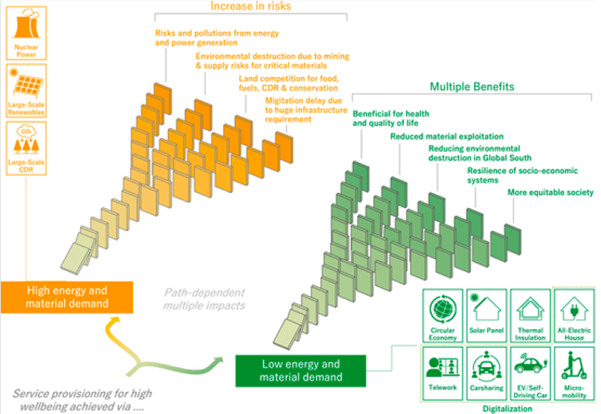
A new commentary, published by members of the Energy Demand Changes Induced by Technological and Social Innovations (EDITS) network, coordinated by IIASA, highlights that switching the focus from how energy is supplied to how energy is consumed can be a more effective approach to reducing carbon emissions with the added benefit of improving wellbeing for all.
Worsening effects of climate change, high market volatility in energy and materials, geopolitical tensions — all of these factors make it extremely difficult for policymakers to ensure the supply of secure, clean, and affordable energy. However, public support for changing the way energy is used has been growing, opening up new opportunities. Reducing energy demand could help save money for households and businesses, create employment, reduce emissions, and improve air quality.
The authors of the commentary argue that improving the ways in which we consume energy to fulfil human needs could lead to a substantial reduction in total energy demand in 2050, and consequently make it easier to decarbonize energy supply. Their paper refers to a global ‘High-with-Low’ scenario that delivers high wellbeing with low energy and material resource consumption, while limiting global warming in line with Paris Agreement targets.
“There are numerous ways for us to dramatically reduce the energy we consume while improving our standards of living, the quality of our cities, and our social wellbeing. Our analysis shows this should be the ‘first best’ strategy for tackling climate change,” says senior IIASA researcher Charlie Wilson, who is one of the authors.
The commentary highlights the need for societal and technological transformations that could form the basis for new lifestyles to create a modern, more just, net-zero world through innovation.
“Placing individual level transformations at the center of solutions to drastically reduce energy consumption globally does not mean shifting the responsibility of climate mitigation to people,” says IIASA researcher and coauthor of the commentary Benigna Boza-Kiss. “On the contrary, it is about empowering people by providing access to the right infrastructure, technology, and incentives. Many new cities will be built in the developing world so there is a huge opportunity to foster inclusive growth by staying clear of unsustainable practices.”
Policymakers often focus on the supply-side, with an emphasis on how to supply energy that is affordable, clean, and secure. The EDITS network members argue that analysis and tailoring of the demand for energy resources can and should play a complementary role in achieving this aim, especially given the risks brought by market volatility and geopolitics.
The authors define demand-side solutions as policies, interventions, and measures that modify demand for goods and services to reduce material and energy requirements, as well as associated GHG emissions, while also contributing to other policy objectives, including improved wellbeing and living standards. For example, measures might promote lifestyle changes and the adoption of certain behaviors, while also aiming to improve the efficiency of supply chains and infrastructure, thereby increasing people’s wellbeing.
The potential benefits of demand-side solutions are promising. According to the Intergovernmental Panel on Climate Change (IPCC) Sixth Assessment Report, demand-side solutions could reduce GHG emissions from end-use sectors like buildings, transport, retail, and industry by 40–70% by 2050, with multi-faceted increases in wellbeing and no corresponding reduction in service levels.
“Research on ‘High-with-Low’ demand-side scenarios is challenging because scenarios have to deal with various demand-side technologies as well as a wide range of cultures and social practices. However, now that the IPCC is entering its new phase, the time is ripe to kick-start a new frontier of climate change mitigation modeling and scenario research,” notes Masahiro Sugiyama, the lead author of the commentary and professor at the University of Tokyo.
The authors point out that some local, national, and international bodies are already encouraging demand-side solutions, such as the local governments of Paris or Barcelona. However, much of the current emphasis in scientific research and modeling focuses on supply-side solutions and removing carbon dioxide from the atmosphere. This includes bioenergy production with carbon capture and storage (CCS), which involves serious trade-offs and risks due to intensive land-use requirements. The fear is that scaling it up could create major competition for land with food producers.
In contrast, low energy and material demand scenarios are under-explored in research. The authors point out that there should be a much greater focus on modeling these scenarios to inform policy and innovation because they minimize the trade-offs we face in tackling climate change. This will require better data on demand, services, wellbeing, business models, and technological innovation, with an accompanying careful selection of indicators key to producing useful models.
The EDITS network is working actively to address these data and modeling needs by bringing together researchers from many different fields as part of a collective effort from researchers, governments, funders, and other stakeholders to help us move towards a sustainable future.
Reference:
Sugiyama, M., Wilson, C., Wiedenhofer, D., Boza-Kiss, B., et al. (2024). High with low: Harnessing the power of demand-side solutions for high wellbeing with low energy and material demand. Joule, 8(1), 1-6. DOI: https://doi.org/10.1016/j.joule.2023.12.014
https://www.sciencedirect.com/science/article/pii/S2542435123005329?dgcid=author
News

22 July 2024
Are sustainable aviation fuels truly sustainable?

17 July 2024
Forests endure as carbon sink despite regional pressures

16 July 2024




